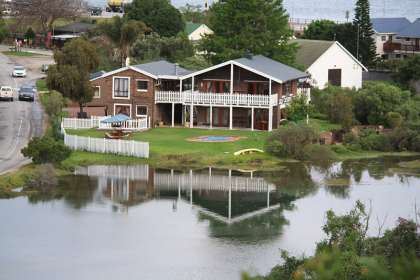Prince Alfred's Pass - nr Knysna, Garden Route, Western Cape
Prince Alfred's Pass - nr Knysna, Garden Route, Western Cape
The Prince Alfred's Pass, connecting Knysna to Uniondale in the Western Cape, is one of South Africa's most remarkable mountain passes, renowned for its breathtaking scenery and engineering marvels. This historic pass, named after Queen Victoria’s second son, Prince Alfred, was constructed in the mid-1800s by the legendary road engineer Thomas Bain. Bain's work on the pass, which involved carving through rugged terrain with minimal resources, stands as a testament to his ingenuity and perseverance, making the Prince Alfred's Pass a notable landmark in South African history.
Stretching approximately 68 kilometers, the pass weaves through the majestic Outeniqua and Tsitsikamma mountains, offering travelers a unique blend of natural beauty and adventure. The route is characterized by its narrow, winding roads, steep gradients, and sharp bends, which provide stunning vistas of deep gorges, indigenous forests, and rocky outcrops. The journey through the pass is not only a visual feast but also a thrilling experience for those who appreciate rugged and challenging drives.
The diverse landscapes along the Prince Alfred's Pass showcase the rich biodiversity of the region. Travelers can encounter a variety of flora and fauna, including endemic plant species and a range of birdlife. The pass also crosses several rivers and streams, adding to the scenic allure with cascading waterfalls and tranquil pools. These natural features make the pass a popular destination for nature enthusiasts, photographers, and adventure seekers who relish the opportunity to explore South Africa's untamed wilderness.
Despite its remote and rugged nature, the Prince Alfred's Pass has significant historical and cultural importance. The pass played a crucial role in opening up trade routes between the coastal town of Knysna and the interior regions, facilitating economic development in the 19th century. Along the route, remnants of old tollhouses and other historical structures can still be seen, providing a glimpse into the pass's storied past. Additionally, the pass's construction by Thomas Bain is often celebrated as a remarkable feat of engineering, showcasing the innovative spirit of that era.
Today, the Prince Alfred's Pass remains a cherished route for adventurous travelers seeking to experience the beauty and history of the Western Cape. Its combination of challenging driving conditions, stunning landscapes, and historical significance make it a must-visit destination for those exploring the region. Whether you're a history buff, a nature lover, or an adrenaline junkie, the Prince Alfred's Pass offers a unique and unforgettable journey through one of South Africa's most captivating areas.
Six facts about the Prince Alfred's Pass:
1. Engineer Extraordinaire: The pass was designed and built by Thomas Bain, a legendary road engineer known for his work on several other mountain passes in South Africa. His ability to construct such a challenging route with limited resources is still celebrated today.
2. Historic Construction: The pass was constructed in the mid-1800s and named after Prince Alfred, Queen Victoria’s second son, who visited the Cape Colony during that period.
3. Scenic Diversity: Stretching approximately 68 kilometers, the pass traverses diverse landscapes, including indigenous forests, deep gorges, rocky outcrops, and river crossings, offering a rich tapestry of natural beauty.
4. Challenging Drive: Known for its narrow, winding roads, steep gradients, and sharp bends, the Prince Alfred Pass is a challenging drive that attracts adventure seekers and those who enjoy rugged, off-the-beaten-path experiences.
5. Biodiversity Hotspot: The pass is home to a wide variety of flora and fauna, making it a haven for nature enthusiasts. Travelers can spot endemic plant species, diverse birdlife, and occasionally, wildlife such as baboons and small antelope.
6. Cultural Significance: The pass played a vital role in the economic development of the region by opening up trade routes between Knysna and Uniondale. Remnants of historical structures, such as old tollhouses, can still be seen along the route, adding to its historical charm.
The Prince Alfred's Pass stands as a symbol of engineering brilliance and natural splendor, offering an unparalleled journey through the Western Cape's dramatic landscapes and rich history.
Who was Thomas Bain?
Thomas Bain, born on September 29, 1830, in Graaff-Reinet, South Africa, was a legendary road engineer and surveyor known for his extraordinary contributions to the development of infrastructure in the Cape Colony during the 19th century. The son of Andrew Geddes Bain, another renowned engineer and geologist, Thomas Bain inherited his father's pioneering spirit and engineering acumen, which he applied to create some of South Africa's most challenging and impressive mountain passes.
Bain's engineering career began under the guidance of his father, who was instrumental in constructing several important routes in the Cape. Thomas Bain's first major solo project was the construction of Michell's Pass near Ceres in 1848. This project marked the beginning of a prolific career that would see Bain designing and building over 20 mountain passes throughout the Cape Colony. His work was crucial in facilitating transportation and trade across the region's rugged and mountainous terrain.
One of Bain's most remarkable achievements was the construction of the Prince Alfred Pass, which links Knysna and Uniondale. This project, undertaken between 1860 and 1867, is often celebrated for its sheer difficulty and the ingenuity required to complete it with the limited resources of the time. Bain's ability to carve routes through some of the most challenging landscapes using manual labor and basic tools is a testament to his engineering prowess and determination.
In addition to his engineering feats, Bain also contributed to the field of geology, continuing his father's legacy. He conducted extensive surveys and mapping of the regions where he worked, often making significant geological observations. Bain's dual expertise in engineering and geology allowed him to understand and navigate the natural obstacles he encountered in his projects.
Thomas Bain's legacy extends beyond his engineering accomplishments. His work had a profound impact on the economic and social development of the Cape Colony, opening up previously inaccessible areas and facilitating the movement of goods and people. His passes remain vital transport routes today, standing as enduring monuments to his skill and vision. Bain passed away on September 29, 1893, but his contributions to South African infrastructure and his pioneering spirit continue to be remembered and celebrated.
Accommodation Near Prince Alfred's Pass - nr Knysna, Garden Route, Western Cape
Protea Wilds Retreat
Self Catering House, Cottage, Chalet Accommodation in Harkerville
11.8km from Prince Alfred's Pass - nr Knysna, Garden Route, Western CapeProtea Wilds Retreat offers self catering accommodation on the outskirts of Harkerville in the Plettenberg Bay area, Garden Route. Safe, peaceful, stunning views, great affordability. Peace and tranquillity like you've never experienced before. …see more for bookings / enquiries and info.
B My Guest
Self Catering Apartment, Flatlet Accommodation in Knysna
12km from Prince Alfred's Pass - nr Knysna, Garden Route, Western CapeB My Guest offers visitors to Knysna, Garden Route with self catering accommodation. Voted South Africa's favourite town, Knysna lies on the shores of an estuary between indigenous forests, Outeniqua mountains and a breathtaking coastline. …see more for bookings / enquiries and info.
The Greens Guest House
Bed & Breakfast Accommodation in Knysna
12.7km from Prince Alfred's Pass - nr Knysna, Garden Route, Western CapeThe Greens Guest House offers guests bed and breakfast accommodation in the heart of the lush Garden Route greenery in the picturesque and popular town of Knysna. An elegant single storey architectural jewel, housing a large open plan living area... …see more for bookings / enquiries and info.
Stannards Guest Lodge
Self Catering House, Cottage, Chalet Accommodation in Knysna
12.7km from Prince Alfred's Pass - nr Knysna, Garden Route, Western CapeStannards Guest Lodge offers both bed and breakfast accommodation and self catering accommodation in Knysna, Garden Route. Located in the peaceful suburb of Hunter's Home in Knysna, five minutes away from the lagoon and world-class golf courses, and... …see more for bookings / enquiries and info.
Oniro on Thesen
Self Catering House, Cottage, Chalet Accommodation in Knysna
12.9km from Prince Alfred's Pass - nr Knysna, Garden Route, Western CapeOniro On Thesen offers self catering accommodation on Thesen Island in Knysna, Garden Route. Located in Thesen Islands and designed for relaxed, easy indoor/outdoor living with large veranda with uninterrupted view of Knysna lagoon and wetlands. …see more for bookings / enquiries and info.
Inyathi Guest Lodge Self Catering
Self Catering House, Cottage, Chalet Accommodation in Knysna
13.5km from Prince Alfred's Pass - nr Knysna, Garden Route, Western CapeInyathi Guest Lodge provides self catering accommodation in Knysna, Garden Route. Our fully equipped self-catering chalets are situated in a highly convenient central location, but down a quiet side street away from the hustle and bustle... …see more for bookings / enquiries and info.
Lagoon Breeze Guest House
Bed & Breakfast Accommodation in Knysna
14.4km from Prince Alfred's Pass - nr Knysna, Garden Route, Western CapeLagoon Breeze is a lovely luxury guest house, with magnificent views of the lagoon and Knysna heads and the ocean beyond. Situated in Knysna on the Western Cape's garden Route and conveniently on the N2 alongside the Knysna lagoon. …see more for bookings / enquiries and info.
Villa Leisure
Self Catering House, Cottage, Chalet Accommodation in Knysna
14.8km from Prince Alfred's Pass - nr Knysna, Garden Route, Western CapeVilla Leisure is a charming two-story self catering villa that combines timeless elegance with modern comfort. The villa features three spacious ensuite bedrooms and three bathrooms, sleeps 6, ensuring ample privacy and convenience. …see more for bookings / enquiries and info.
Lagoon Lodge
Self Catering Apartment, Flatlet Accommodation in Knysna
15km from Prince Alfred's Pass - nr Knysna, Garden Route, Western CapeLagoon Lodge provides both bed and breakfast accommodation and self catering accommodation in Knysna, Garden Route. If you need a break-away to an elegant and romantic setting, we are ready to treat you and your loved one, in our brand new lodge! …see more for bookings / enquiries and info.
Salt River Lodge
Self Catering Apartment, Flatlet Accommodation in Knysna
15.1km from Prince Alfred's Pass - nr Knysna, Garden Route, Western CapeSalt River Lodge offers self catering accommodation in Knysna, Garden Route. Set in a supremely tranquil location, situated on the northern side of the lagoon with its natural ebb and flow of the tide. …see more for bookings / enquiries and info.
- De Vlugt (8.33km)
- Harkerville (11.11km)
- Horn Lee, Knysna (11.30km)
- Flenters, Knysna (11.61km)
- Old Place, Knysna (11.72km)
- Fisher Haven, Knysna (12.17km)
- Pezula Private Estate, Knysna (12.22km)
- Costa Sarda, Knysna (12.36km)
- Noetzie (12.54km)
- Hunters Home, Knysna (12.55km)
- Sparrebosch, Knysna (13.11km)
- Rexford, Knysna (13.22km)
- Knysna Central (13.37km)
- Knysna (13.39km)
- Fernwood Estate, Knysna (13.47km)
- Outeniqua Hiking Trail - Garden Route, Western Cape (0.66km)
- Simola Golf Course - Knysna, Garden Route (12.55km)
- Knysna Golf Club - Knysna, Garden Route (12.98km)
- Pezula Golf Club & Championship Course - Knysna, Garden Route (13.06km)
- Millwood House Museum - Knysna, Garden Route (13.14km)
- Pledge Nature Reserve - Knysna, Garden Route (13.39km)
- The Waterfront Knysna Quays - Knysna, Garden Route (13.82km)
- Simola Hillclimb, Knysna Speed Festival - Knysna, Garden Route (13.98km)
- Knysna Lagoon - Knysna, Garden Route (14.87km)
- Knysna National Lake Area - Knysna, Garden Route (14.89km)
- Harkerville Trail - between Knysna and Plettenberg Bay (14.91km)
- Knysna Heads - Knysna, Garden Route (15.43km)
- Featherbed Private Nature Reserve - Knysna, Garden Route (16.36km)
- Knysna Elephant Park - Plettenberg Bay, Garden Route (18.92km)
- Plettenberg Bay Game Reserve - Garden Route, Western Cape (19.61km)
 The Prince Alfred's Pass at 88km long is the longest mountain pass in South Africa by a considerable margin ©
The Prince Alfred's Pass at 88km long is the longest mountain pass in South Africa by a considerable margin © 










